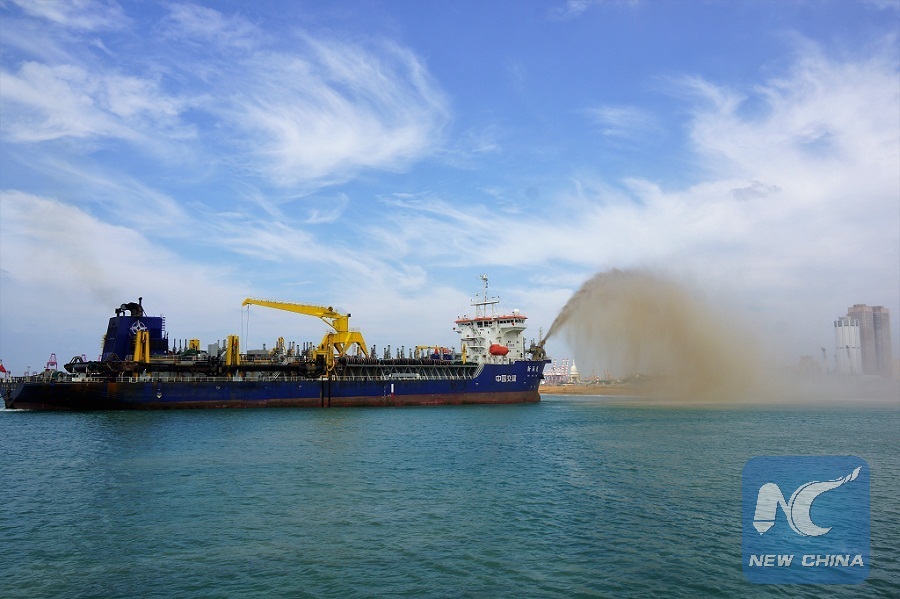
The file photo shows a Chinese dredger works at the construction site of the Colombo Port City project in Colombo Port City, Colombo, Sri Lanka in Dec. 16, 2017. (Xinhua/Tang Lu)
by Zhu Ruiqing, Tang Lu
COLOMBO, March 16 (Xinhua) -- In recent years, western scholars and media have been pointing fingers at China-Sri Lanka cooperation under the China-proposed Belt and Road Initiative, accusing China of leading Sri Lanka into a "debt trap".
However, with cooperation between the two countries growing stronger and broader, such accusations have been proven to be totally baseless.
The cooperation between China and Sri Lanka dates back to decades ago. Even during Sri Lanka's civil war which lasted for nearly 30 years and ended in 2009, China helped Sri Lanka by constructing the A9 Highway in the war-torn areas.
Years later, in 2013, China continued to assist Sri Lanka by constructing the 96-km Southern Expressway which links capital Colombo to the southern city of Galle.
It is also helping Sri Lanka to build its first new railway line, the 26.75-km long Matara-Beliatta railway extension project.
Sri Lanka earlier this year conducted a test run along the newly constructed railway line, which will be completed later this year. In the future, the new expressways and railways are expected to increase traffic into the south and boost trade between capital Colombo and the deep south.
Apart from the transport sector, the cooperation between China and Sri Lanka has also extended into many other areas, among which the two countries are now working to transform Sri Lanka into a maritime center in the Indian Ocean region.
In the west of the island country, China's CM Port and the state-owned Sri Lanka Ports Authority started their cooperation in running the Colombo International Container Terminals (CICT) in 2014.
Driven by CICT, the Colombo Port has become one of the fastest growing ports in the global market. According to international rating agency Alphaliner, the Colombo Port is ranked the world's Number 1 port with the highest container growth in the first half of 2018.
Furthermore, in the southern end of the island, the cooperation in the ports industry also began a new journey when in 2017, two joint ventures between CM Port and Sri Lanka Ports Authority got underway to co-run the Hambantota Port, which is located only 10 nautical miles away from the international shipping route in the Indian Ocean.
Chairman of Sri Lanka Ports Authority Parakrama Dissanayake told Xinhua in an interview that with a partnership with CM Port, Sri Lanka will be able to establish its presence in a significant manner in the global maritime industry.
Among all current cooperation projects in Sri Lanka, there is one particularly noteworthy, the Colombo Port City.
Spread over a piece of reclaimed land from the sea, adjacent to the commercial district of Colombo, the Colombo Port City, co-developed by the Sri Lankan government and China's CHEC Port City Colombo (Pvt) Ltd, a subsidiary of the China Communications Construction Company Limited (CCCC), will become a commercial, financial, residential and international entertainment hub in the Indian Ocean in the future.
The total land reclamation of 269 hectares for the Colombo Port City was completed earlier this year, and the construction of infrastructure facilities is underway and is due to be completed by mid 2020.
According to Sri Lankan Prime Minister Ranil Wickremesinghe, the Colombo Port City will transform Colombo into a financial and trading hub.
So far, the Colombo Port City has created more than 4,000 jobs for the local people, benefiting thousands of Sri Lankan families. And in the future, the project will attract 13 billion U.S. dollars' worth of investments within the city.
Speaking of Sri Lanka's debt problem, local scholar Dr. Dushni Weerakoon and Professor of Economics at Australia's Monash University, Sisira Jayasuriya, co-wrote an article recently, stating that Sri Lanka's debt problem was not created by China.
The article said, Sri Lanka's debt repayment problems had very little to do with Chinese loans. Chinese loans comprise merely about 10 percent of Sri Lanka's total foreign debt.
Chinese Ambassador to Sri Lanka Cheng Xueyuan has said that under the guidance of consensus reached by leaders from the two countries, China-Sri Lanka economic and trade cooperation will inject new vigor to Sri Lanka's economic and social development, enable development achievements to better benefit the two peoples.

